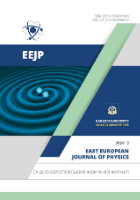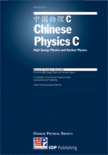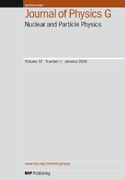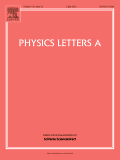
Moscow University Physics Bulletin
Scope & Guideline
Illuminating the Path of Scientific Discovery
Introduction
Aims and Scopes
- Nuclear Physics:
The journal publishes studies on nuclear reactions, photonuclear research, and related experimental techniques. This includes investigations into nuclear structure, decay processes, and applications of nuclear physics in medical and environmental contexts. - Condensed Matter Physics:
Research articles focus on the properties of materials at the atomic and molecular levels, including studies on superconductors, magnetism, and phase transitions. The journal highlights both theoretical models and experimental findings. - Plasma Physics and Laser Technology:
Publications related to the behavior of plasma under various conditions, as well as advancements in laser technology for applications in industry and research. This includes studies on laser-plasma interactions and the development of laser-based diagnostics. - Astrophysics and Geophysics:
The journal features research on astronomical phenomena, including stellar evolution and cosmic events, as well as studies on geophysical processes such as seismic activity and atmospheric dynamics. - Machine Learning Applications in Physics:
An emerging area within the journal, focusing on the use of machine learning techniques for data analysis, simulation, and modeling in various physics domains, enhancing the interpretation and processing of complex datasets. - Interdisciplinary Approaches:
The journal encourages studies that intersect with other scientific disciplines, including biophysics, materials science, and environmental physics, showcasing the broad applicability of physics principles.
Trending and Emerging
- Machine Learning and AI in Physics:
An increasing number of papers utilize machine learning and artificial intelligence techniques for data analysis and modeling. This trend underscores the growing importance of computational methods in extracting insights from complex datasets. - Nanotechnology and Materials Science:
Research focusing on nanostructured materials and their unique properties is on the rise. This includes studies on nanocomposites, magnetic nanoparticles, and their applications in various fields, reflecting the significance of nanotechnology. - Environmental Physics:
There is a growing emphasis on the impact of physical phenomena on environmental issues, including climate change and pollution. Research in this area often combines physics with interdisciplinary approaches to address global challenges. - Quantum Technologies:
Publications related to quantum computing, quantum communication, and other applications of quantum mechanics are becoming more prevalent, indicating a burgeoning interest in harnessing quantum phenomena for technological advancements. - Astrophysical Phenomena and Cosmic Events:
Research on cosmic events such as supernovae, gamma-ray bursts, and the implications of such phenomena for astrophysics is gaining attention, reflecting an ongoing interest in understanding the universe.
Declining or Waning
- Classical Mechanics:
Research centered on classical mechanics has decreased, possibly due to the increasing emphasis on modern physics topics, quantum mechanics, and computational methods that offer more innovative insights. - Traditional Experimental Techniques:
The reliance on conventional experimental methods has waned as new technologies, such as advanced imaging and computational simulations, gain traction. This shift reflects a broader trend towards more sophisticated and automated experimental setups. - Basic Thermodynamics:
Studies that address fundamental thermodynamic principles have become less common, likely overshadowed by more specialized research that integrates thermodynamics with other fields such as nanotechnology and materials science.
Similar Journals

Condensed Matter Physics
Exploring the Depths of Condensed Matter ScienceCondensed Matter Physics is a prestigious open-access journal published by the Institute of Condensed Matter Physics, National Academy of Sciences Ukraine. Since its inception in 1993, this journal has been dedicated to the dissemination of high-quality research in the field of condensed matter physics, providing a platform for scientists worldwide to share their latest findings. With an ISSN of 1607-324X and an E-ISSN of 2224-9079, it caters to a diverse audience, including researchers, professionals, and students. Although classified in the Q4 quartile for both condensed matter physics and miscellaneous physics and astronomy category, the journal plays a vital role in fostering communication among experts and advancing knowledge in this dynamic field. It is particularly vital for emerging researchers as it supports open access, ensuring that critical research is available to all, removing barriers to information. The journal's relevance remains steadfast, covering a wide array of topics and encouraging interdisciplinary approaches, and it is poised to inspire future scientific explorations until at least 2024.

East European Journal of Physics
Fostering collaboration through open-access scholarship.The East European Journal of Physics, published by the V N Karazin Kharkiv National University, is a dynamic open-access journal dedicated to advancing research in the fields of Physics and Materials Science. Since its inception in 2014, the journal has become a platform for scientists and academicians throughout Eastern Europe and beyond, fostering collaboration and dissemination of innovative studies and findings. With its ISSN 2312-4334 and E-ISSN 2312-4539, it attracts a global readership and submissions that are rigorously peer-reviewed to ensure the highest scholarly standards. Despite currently holding a Q4 category ranking in both Materials Science and Physics and Astronomy, as well as modest Scopus rankings, the journal is positioned to play a crucial role in elevating the visibility and impact of research emanating from this geographically and scientifically significant region through an open access model. This commitment to open scholarship is critical for fostering academic exchange and impact, making the East European Journal of Physics a valuable resource for researchers, professionals, and students seeking insight into the latest developments within these fields. Join us in exploring the frontiers of knowledge and innovation from Ukraine and its surrounding areas.

Papers in Physics
Exploring innovative research in the heart of physics.Papers in Physics is a reputable, open-access journal dedicated to advancing knowledge in the diverse fields of physics, materials science, and theoretical chemistry. Published by the Instituto de Física Líquidos y Sistemas Biológicos in Argentina, this journal has been disseminating groundbreaking research since 2009 and has quickly established its place within the academic community. With a consistent commitment to accessibility, it serves as a vital resource for professionals, researchers, and students alike, enriching the discourse with innovative studies and findings. As recognized by its 2023 Scopus rankings, the journal occupies Q3 quartile positions across several categories, including Materials Science and Physics, illustrating its relevance and impact in the scientific landscape. The journal's breadth of research encompasses interdisciplinary approaches, fostering collaboration among scholars from various domains. Whether you are seeking to publish your own research or exploring the latest developments in physics and its related fields, Papers in Physics stands as a critical platform for the dissemination of knowledge and the advancement of science.

PHYSICS OF PARTICLES AND NUCLEI
Exploring the Frontiers of Nuclear PhysicsPhysics of Particles and Nuclei is an esteemed journal within the field of nuclear and high energy physics, published by Pleiades Publishing Inc. Based in the United States, this journal has been a vital platform for disseminating cutting-edge research since its inception in 1996, with coverage extending until 2024. Indexed under the ISSN 1063-7796 and the E-ISSN 1531-8559, it has established itself as a noteworthy publication, currently categorized in the Q3 quartile according to the 2023 standards for Nuclear and High Energy Physics. With its Scopus ranking placing it at #62 out of 87 in its category, Physics of Particles and Nuclei provides unique insights and discussions that resonate with academics, researchers, and students alike. Although it does not offer open access, the journal continues to serve as a crucial resource for those looking to engage deeply with the latest advancements and theoretical explorations in particle and nuclear physics.

Physics of Particles and Nuclei Letters
Charting New Territories in Nuclear ResearchPhysics of Particles and Nuclei Letters, published by PLEIADES PUBLISHING INC, serves as a pivotal platform for the dissemination of cutting-edge research in the domains of particle and nuclear physics. With an ISSN of 1547-4771 and an E-ISSN of 1531-8567, this journal has been actively contributing to the scientific community since its inception in 2006 and continues to be influential, with a convergence period extending to 2024. While its open access options are limited, the journal is recognized for its rigorous peer-review process and commitment to quality, as reflected in its Scopus rankings across multiple categories, including a Q3 in Nuclear and High Energy Physics and Radiation in 2023. The journal is positioned to be a vital resource for researchers aiming to bridge theoretical understanding with practical applications in these highly specialized fields, fostering advances that resonate within atomic and molecular physics, radiology, and beyond. Its relevance continues to grow as the global scientific community seeks innovative solutions to complex problems in modern physics.

EPL
Exploring New Horizons in Scientific ResearchEPL, a prominent journal published by IOP Publishing Ltd, stands at the forefront of the field of Physics and Astronomy. With a history of impactful contributions stretching from 1986 to 2024, EPL serves as a dynamic platform for researchers to disseminate their pioneering findings and innovative ideas. The journal, with a current category ranking of Q2 among its peers and a competitive Scopus rank of #101 out of 243 in the general physics and astronomy category, reflects its substantial reputation and contribution to the scientific community. Although it operates under a traditional subscription model, EPL's reach is extensive, enabling access to a diverse readership that includes academicians, industry professionals, and students alike. By fostering interdisciplinary collaboration and promoting rigorous research, EPL continues to play a vital role in shaping the future of physics and astronomy.

Chinese Physics C
Connecting Global Minds in Physics ExplorationChinese Physics C is a premier, peer-reviewed journal published by IOP Publishing Ltd, dedicated to advancing knowledge in the fields of Astronomy and Astrophysics, Instrumentation, and Nuclear and High Energy Physics. With an impressive impact factor reflecting its standing in the Q1 quartile across multiple categories, this journal serves as a vital resource for researchers, professionals, and students seeking to engage with cutting-edge developments and experimental findings. Since its inception in 2008, Chinese Physics C has fostered significant collaborations and discussions within the global physics community, enabling easy access to high-quality research through its open access options. Operating from the United Kingdom with a commitment to excellence, this journal not only showcases high-impact papers but also encourages innovative methodologies and interdisciplinary approaches, solidifying its role as an essential platform for dissemination and dialogue in the rapidly evolving landscape of physics.

INTERNATIONAL JOURNAL OF MODERN PHYSICS A
Driving innovation in astronomy, atomic, and nuclear physics.INTERNATIONAL JOURNAL OF MODERN PHYSICS A, published by WORLD SCIENTIFIC PUBL CO PTE LTD, stands as a pivotal platform in advancing the frontiers of research within the fields of Astronomy and Astrophysics, Atomic and Molecular Physics, and Nuclear and High Energy Physics. Established in 1989, this journal has systematically contributed to the scientific community, with a demonstrated impact as indicated by its Q2 category rankings across these critical disciplines in 2023. Researchers and professionals are encouraged to engage with its rigorous peer-reviewed content, fostering a deeper understanding of modern physics theories and experimental breakthroughs. Although the journal operates under a conventional access model, it remains a vital resource for those seeking to disseminate their findings and stay abreast of cutting-edge developments. With an emphasis on quality and breadth of research, the journal continues to attract submissions from leading physicists and scholars, enhancing its reputation as a key academic resource.

JOURNAL OF PHYSICS G-NUCLEAR AND PARTICLE PHYSICS
Illuminating the Universe Through Groundbreaking ResearchJOURNAL OF PHYSICS G-NUCLEAR AND PARTICLE PHYSICS, published by IOP Publishing Ltd, stands as a premier journal in the realm of Nuclear and High Energy Physics. With an established presence since 1989 and currently converging toward 2024, this influential journal emphasizes groundbreaking research and discoveries in particle physics, fostering the dissemination of knowledge among a global audience of researchers, professionals, and students. Recognized for its high-quality publications, it holds a Q1 ranking in its category for 2023, placing it at an impressive 87th percentile among 87 journals in its field as per Scopus Rankings. The journal's impact is reflected in its esteemed reputation, making it an essential resource for advancing the frontiers of physics. Although it currently does not operate under an open access model, the journal ensures that subscribers receive comprehensive insights into the latest developments and theoretical advances that shape our understanding of the universe.

PHYSICS LETTERS A
Accelerating Knowledge in the World of PhysicsPhysics Letters A is a renowned scientific journal published by Elsevier, dedicated to the field of physics and astronomy. Established in 1963, it has continuously evolved, offering a platform for the swift dissemination of significant research findings in various branches of physics. As of 2023, it holds a commendable Q2 ranking in the category of Physics and Astronomy (miscellaneous) and ranks 69th out of 243 journals in the same domain according to Scopus, positioning itself in the 71st percentile of academic impact. With its comprehensive scope, Physics Letters A provides a vital resource for researchers, professionals, and students, facilitating academic discourse and advancing knowledge across the field. Although it does not currently offer Open Access options, its rigorous peer-review process ensures high-quality content. It is centrally located in Amsterdam, Netherlands, and continues to be an essential outlet for innovative contributions to the physics community through the year 2024 and beyond.